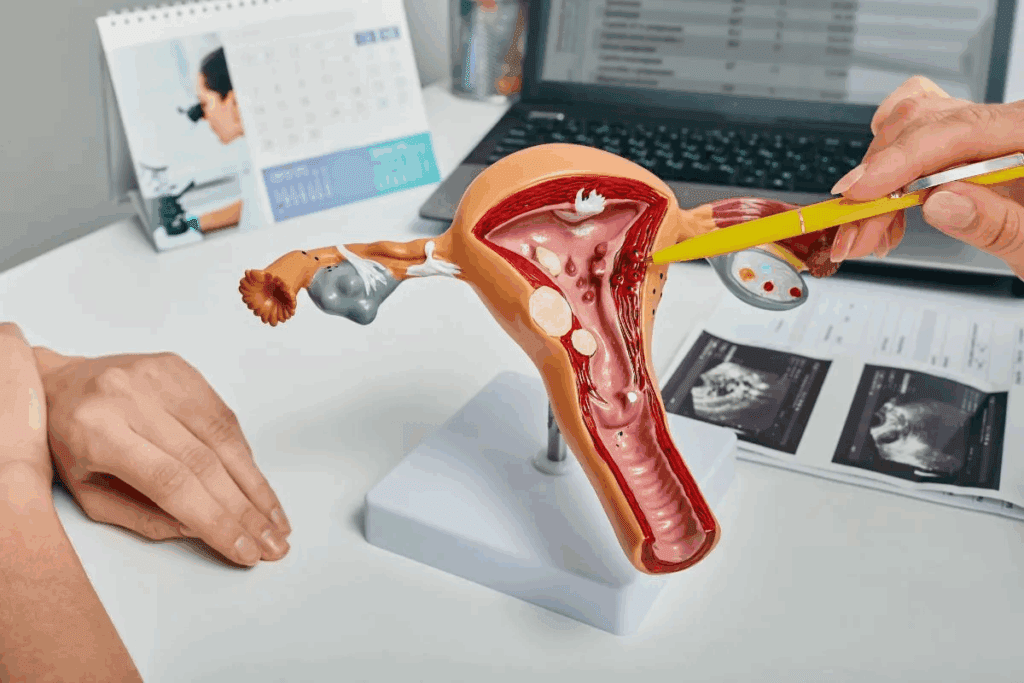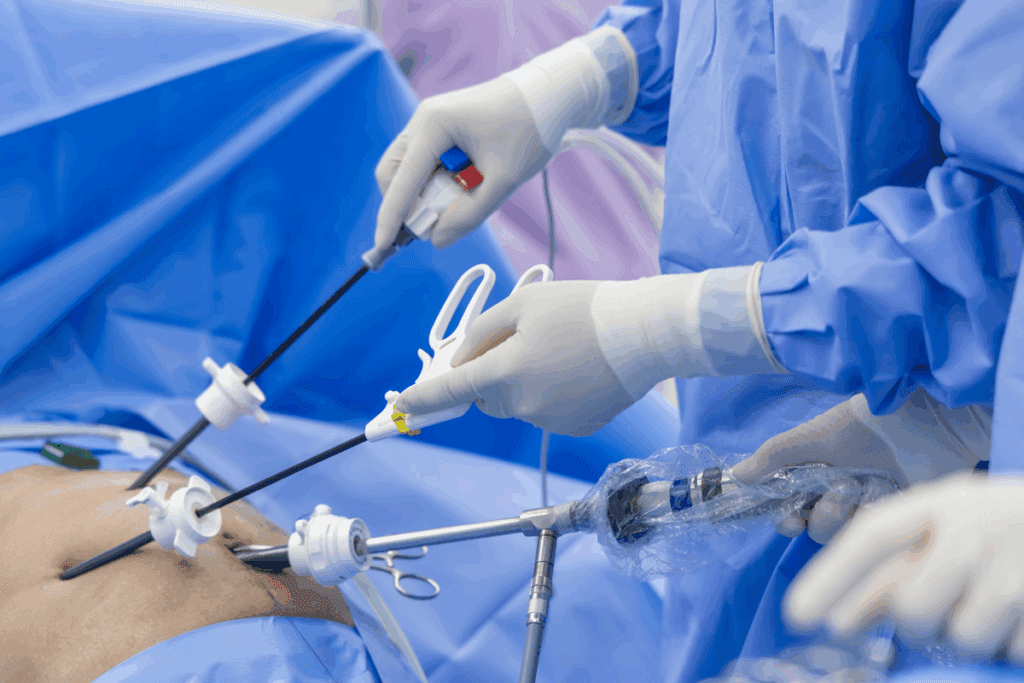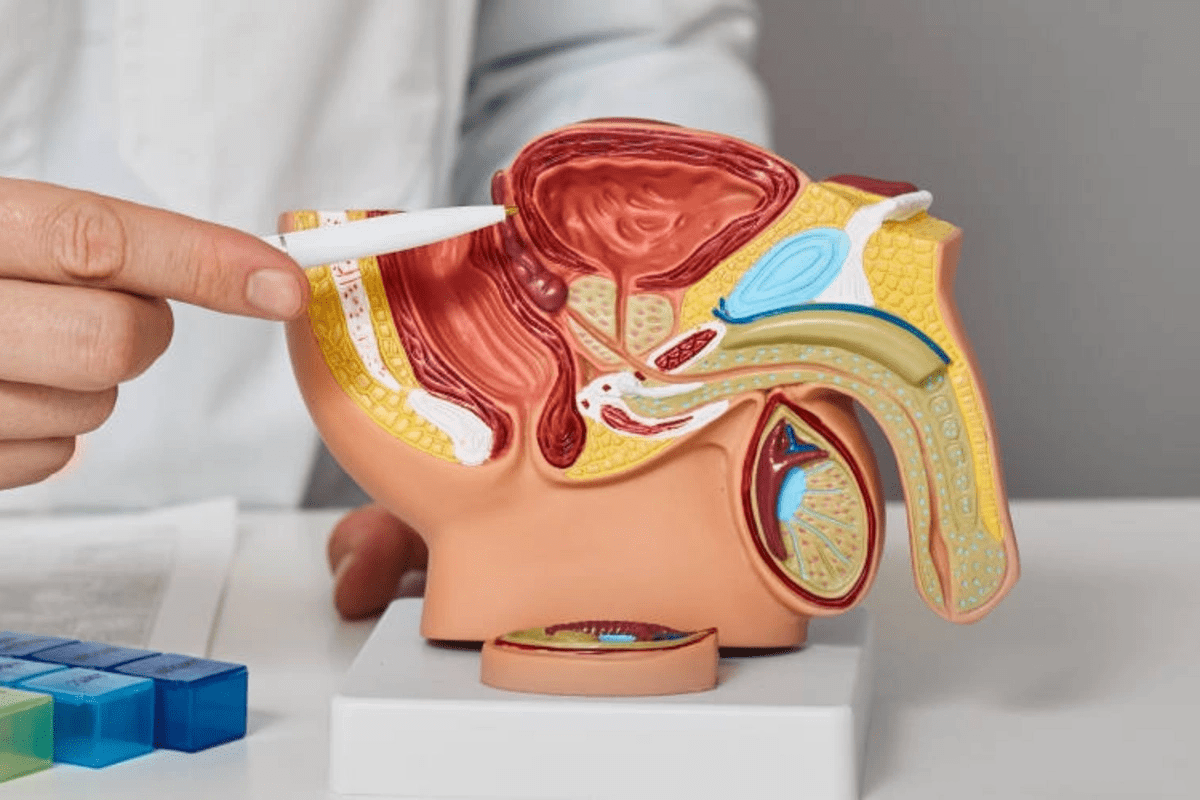Last Updated on November 26, 2025 by Bilal Hasdemir

Many people worry about the side effects of fibroid surgery. They are looking for ways to treat an enlarged uterus and fibroids.Learn 7 critical fibroids surgery side effects. Our guide explains the risks of fibroid removal and effective relief treatments.
At Liv Hospital, we focus on our patients. We know how important it is to know about the risks and the latest treatments.
We know that fibroid surgery, like myomectomy or hysterectomy, can work well. But, it also has risks. We aim to give you all the info you need to make a good choice.
Key Takeaways
- Understanding the possible risks of fibroid surgery.
- Looking into treatments for an enlarged uterus and fibroids.
- The value of patient-focused care in fibroid treatment.
- Our trusted skills in doing hysterectomy and myomectomy.
- Helping international patients with their health needs.
Understanding Uterine Fibroids and Their Impact on Women’s Health

Uterine fibroids are benign tumors in the uterus. They are a major cause of gynecological symptoms and surgeries. These tumors can be different in size, number, and location. This affects how severe symptoms are and how much they impact a woman’s life.
What Are Uterine Fibroids and Who Gets Them
Uterine fibroids are non-cancerous growths in or around the uterus. They are common in women of childbearing age. Studies show up to 80% of women may get fibroids by 50.
The exact cause is not known. But hormones, genetics, and environment are thought to play a part.
Risk factors include being 30 to 50 years old, having a family history, being overweight, and eating a lot of red meat and little green veggies, fruits, and dairy.
Common Symptoms That Lead to Seeking Treatment
Symptoms of uterine fibroids vary. Common ones are heavy or prolonged menstrual bleeding, pelvic pain, frequent urination, constipation, and fertility issues. How bad these symptoms are often decides if treatment is needed.
Women with these symptoms might look for treatment to ease pain, manage bleeding, or improve fertility. They usually do this because symptoms affect their daily life and happiness.
When Surgical Intervention Becomes Necessary
Surgery for uterine fibroids is considered when symptoms are severe or impact life a lot. The type of surgery depends on the fibroids’ size, number, and location. It also depends on if the woman wants to keep her fertility.
In summary, knowing about uterine fibroids and their effects on women’s health is key for making treatment choices. By understanding symptoms and risk factors, women can get the right medical care. This might help avoid more serious surgeries.
Types of Fibroid Surgery Procedures and Their Effectiveness

Women with uterine fibroids need to know about the different surgeries available. This knowledge helps them make the best choice for their health. We’ll look at the various surgical options, their benefits, and what to expect.
Myomectomy: Removing Fibroids While Preserving the Uterus
A myomectomy removes fibroids but keeps the uterus. It’s a good choice for women who want to keep their fertility or uterus. Myomectomy is effective because it relieves symptoms and keeps reproductive options open.
Research shows myomectomy can greatly reduce bleeding and pain. But, some women might see fibroids come back. Studies say up to 25% of women might have fibroids return within 5 years.
Hysterectomy for Enlarged Uterus and Fibroids: A Definitive Solution
A hysterectomy removes the uterus and is a lasting fix for fibroids. It’s often suggested for big or many fibroids, or when other treatments don’t work. Hysterectomy is a sure way to stop fibroid symptoms, with no chance of them coming back.
Even though hysterectomy works well, it’s a big surgery. Women who want to keep their ability to have children should think carefully about it. Talking it over with a doctor is important.
Laparoscopic and Robotic Surgical Approaches
Laparoscopic and robotic surgeries are less invasive than traditional surgery. They use small cuts, causing less damage and pain. These methods lead to quicker healing, less pain, and smaller scars.
Robotic surgery is even more precise and flexible. It makes complex surgeries easier. Research shows it can mean shorter hospital stays and quicker recovery times than traditional laparoscopy.
Choosing between these surgeries depends on many things. These include the size, number, and location of fibroids, and the patient’s health and wishes. A doctor’s full evaluation is key to picking the right surgery.
| Surgical Procedure | Benefits | Considerations |
| Myomectomy | Preserves fertility, alleviates symptoms | Risk of fibroid recurrence |
| Hysterectomy | Permanent solution, eliminates recurrence risk | Major surgery, impacts fertility |
| Laparoscopic/Robotic Surgery | Minimally invasive, less recovery time | Requires specialized skill, equipment |
“The choice of surgical procedure for fibroids should be tailored to the individual patient’s needs, taking into account factors such as fertility desires and the extent of fibroid disease.”
Fibroids Surgery Side Effects: The 7 Key Risks Explained
When thinking about fibroids surgery, knowing the possible side effects is key. This surgery, though sometimes needed, has risks patients should know about.
Heavy Bleeding During and After Procedures
Heavy bleeding is a big risk with fibroids surgery. It can happen during or after the surgery. Heavy bleeding might need blood transfusions or more surgery.
A study in the Journal of Minimally Invasive Gynecology shows surgeons worry about bleeding during myomectomy. This is a surgery to remove fibroids.
Infection and Inflammatory Complications
Infection is another risk of fibroids surgery. Like any surgery, there’s a chance of infection at the site or inside. Inflammatory complications can also happen, leading to serious issues if not treated right.
To lower these risks, doctors often give antibiotics after surgery.
Scarring and Adhesion Formation
Scarring and adhesions are common with surgery, including fibroids surgery. Adhesions can cause problems like bowel obstruction or chronic pain.
Doctors and surgeons are always working to reduce these risks. They use new techniques and care plans.
Potential Impact on Fertility and Pregnancy
Fibroids surgery can affect fertility and pregnancy. Even though surgeries like myomectomy aim to keep fertility, there are risks. These could impact future pregnancies.
| Potential Risks | Description | Mitigation Strategies |
| Heavy Bleeding | Bleeding during or after surgery | Blood transfusions, surgical interventions |
| Infection | Infection at the surgical site or internally | Antibiotics, proper wound care |
| Scarring and Adhesions | Formation of scar tissue and adhesions | Advanced surgical techniques, post-operative care |
It’s important to understand these risks and talk to a healthcare provider. This helps make a well-informed choice about fibroids surgery.
Recovery Timeline: What to Expect After Fibroid Surgery
Knowing what to expect after fibroid surgery is key. It helps patients manage their recovery and heal smoothly. The time it takes to recover can change based on the surgery type, health, and personal factors.
Hospital Stay and Immediate Post-Operative Care
The recovery starts right after surgery. The hospital stay can last from a few hours to a couple of days. This depends on the surgery’s complexity and the patient’s health.
During this time, doctors watch over vital signs, manage pain, and look for any complications.
Key aspects of immediate post-operative care include:
- Effective pain management through medication
- Monitoring for signs of infection or bleeding
- Early mobilization to prevent blood clots and promote healing
- Clear instructions for post-discharge care
First Month Recovery Milestones
The first month is a key time for healing. Patients can look forward to several milestones:
- Gradual reduction in pain and discomfort
- Return to light activities and gentle exercises
- Normalization of menstrual cycle (though this may take longer)
- Follow-up appointments with healthcare providers to monitor healing
Long-Term Healing and Return to Normal Activities
Recovery time can vary a lot. Most people can get back to normal in 4-6 weeks. But, it can take months for full strength and healing.
Tips for a smooth recovery:
- Follow post-operative instructions carefully
- Maintain a healthy diet rich in nutrients
- Stay hydrated and avoid strenuous activities as advised
- Attend follow-up appointments to monitor progress
How to Stop Heavy Bleeding from Fibroids: Surgical and Medical Options
Heavy bleeding from fibroids can be very hard to deal with. But, there are many ways to manage it. We’ll look at the different methods to stop heavy bleeding from fibroids.
Emergency Interventions for Severe Bleeding
When bleeding is severe, you need help right away. Emergency interventions might include staying in the hospital. Doctors might do dilation and curettage (D&C) to remove fibroids or stop the bleeding.
Tranexamic Acid and Fibroids
Tranexamic acid is a medicine that can lessen heavy bleeding from fibroids. It helps by stabilizing blood clots so they don’t break down. Research shows it can cut down menstrual blood loss in women with fibroids.
Hormonal Treatments to Control Bleeding
Hormonal treatments are also used to manage heavy bleeding from fibroids. They help regulate menstrual cycles and reduce bleeding. Birth control pills and gonadotropin-releasing hormone (GnRH) agonists are common treatments.
It’s important for women with heavy bleeding from fibroids to know about treatment options. By looking at both surgery and medicine, doctors can help manage symptoms well.
Can Fibroids Be Removed Without Major Surgery?
Minimally invasive treatments offer new hope for women looking to avoid major surgery for fibroid removal. The thought of surgery can be scary. Many women are looking for less invasive options that won’t disrupt their lives too much.
Thanks to medical technology advances, several effective alternatives exist. Let’s dive into these options, starting with Uterine Artery Embolization (UAE).
Uterine Artery Embolization (UAE): Process and Results
Uterine Artery Embolization is a minimally invasive procedure. It cuts off the blood supply to fibroids. This helps shrink the fibroids, reducing symptoms and improving life quality.
The process involves injecting tiny particles into the arteries that supply blood to the fibroids. This is done through a small catheter inserted into the artery in the leg. The procedure is usually done under local anesthesia and sedation, allowing patients to go home the same day.
Studies show UAE can significantly reduce fibroid size and symptoms in many women. But, as with any medical procedure, there are risks and side effects to consider.
Focused Ultrasound Surgery (FUS): Non-Invasive Fibroid Treatment
Focused Ultrasound Surgery (FUS) is a non-invasive treatment. It uses high-frequency sound waves to target and destroy fibroid tissue. This procedure is typically performed under MRI guidance, allowing for precise targeting of the fibroids.
FUS is an attractive option for women who wish to avoid incisions and hospital stays. The procedure is usually well-tolerated, with most women experiencing only mild side effects.
While FUS is not suitable for all women with fibroids, it can be an effective treatment for those who are eligible. We will discuss the specifics of who can benefit from FUS and what to expect during the procedure.
Radiofrequency Ablation: Targeted Fibroid Destruction
Radiofrequency Ablation (RFA) is another minimally invasive technique used to treat fibroids. This procedure involves using heat generated by radiofrequency waves to destroy fibroid tissue.
RFA can be performed under ultrasound or MRI guidance, ensuring accurate targeting of the fibroids. The procedure is typically done on an outpatient basis, and recovery times are generally short.
By exploring these alternatives to major surgery, we can offer women a range of effective treatment options tailored to their individual needs and preferences.
What Will Shrink Fibroids: Medical Treatments and Their Efficacy
Women looking for surgery alternatives have medical treatments that can shrink fibroids. These options are less invasive and aim to ease symptoms and enhance life quality.
GnRH Analogs: Achieving Up to 50% Fibroid Reduction
Gonadotropin-releasing hormone (GnRH) analogs are medications that can significantly reduce fibroid size. They induce a temporary menopausal state, shrinking fibroids by up to 50%. This reduction can provide substantial relief from symptoms such as heavy bleeding and pelvic pressure. Yet, it’s important to note that GnRH analogs are usually used for short-term treatment due to side effects like bone density loss.
“GnRH analogs have been shown to be effective in reducing fibroid size, providing a valuable treatment option for women with symptomatic fibroids.” – Dr. Jane Smith, Obstetrics and Gynecology Specialist
Selective Progesterone Receptor Modulators (SPRMs)
Selective Progesterone Receptor Modulators (SPRMs) are another medical treatment for fibroids. SPRMs work by modulating the progesterone receptor, which is involved in fibroid growth. Clinical trials have shown that SPRMs can effectively reduce fibroid size and alleviate symptoms. SPRMs may have a more tolerable side effect profile compared to GnRH analogs, making them a promising option for longer-term treatment.
Limitations and Regrowth Concerns with Medical Therapy
While medical treatments like GnRH analogs and SPRMs are effective, there are limitations and concerns about regrowth. Once treatment is stopped, fibroids may regrow, potentially returning to their original size. This means careful consideration of treatment duration and the need for maintenance therapy is necessary. The impact of these treatments on fertility and long-term health must also be evaluated on an individual basis.
In conclusion, medical treatments are a valuable option for women looking to shrink fibroids without surgery. Understanding the efficacy and limitations of treatments like GnRH analogs and SPRMs helps healthcare providers tailor treatment plans. This improves outcomes and enhances quality of life.
Hysterectomy Side Effects: Long-Term Implications to Consider
Choosing to have a hysterectomy is a big decision. It can change a woman’s health and life in many ways. Knowing the possible long-term side effects is important.
Permanent Fertility Loss and Family Planning Considerations
A hysterectomy means you can’t have children anymore. This is a big deal for women who want kids. It can also affect their feelings and thoughts deeply.
If you’re thinking about having kids, talk to your doctor first. Knowing you can’t have kids anymore helps you make choices about your future.
Hormonal and Physical Changes After Uterus Removal
Removing the uterus can change your body and hormones. Even though your ovaries keep making hormones, some women might feel different. They might get hot flashes or feel moody.
Your body might also change in other ways. You might feel pelvic pressure or have trouble with your bladder or bowels. Knowing these changes can help you deal with them better.
| Physical Changes | Potential Symptoms | Management Strategies |
| Pelvic Organ Prolapse | Pelvic pressure, discomfort | Pelvic floor exercises, supportive devices |
| Changes in Bladder Habits | Urinary incontinence, frequency | Bladder training, pelvic floor exercises |
| Changes in Bowel Habits | Constipation, bowel incontinence | Dietary adjustments, bowel training |
Psychological and Emotional Impact of Hysterectomy
Having a hysterectomy can affect your mind and feelings. You might feel sad or miss your old body. It’s normal to feel this way.
Having people you can talk to is important. This could be family, friends, or a counselor. Knowing you’re not alone can help a lot.
Understanding what a hysterectomy means for the long term helps you prepare. Always talk to your doctor about any worries or questions you have. This way, you can get the best care possible.
Natural and Complementary Approaches to Fibroid Relief
There are many natural ways to help with fibroids, aside from traditional treatments. These options can offer relief and are worth exploring. It’s important to look at the evidence and benefits they might bring.
Dietary Modifications That May Help Manage Fibroids
Eating right is key to health, and some foods can help with fibroids. Eating more fruits, veggies, and whole grains can help manage fibroids. Some studies show that foods high in antioxidants and fiber are good.
“A healthy diet is key in managing fibroids,” says a top healthcare provider. “Eating foods rich in nutrients can really help with symptoms.”
- Foods high in omega-3s, like salmon and flaxseeds, can reduce inflammation.
- Less processed foods and sugars are also good.
- Green tea, full of antioxidants, might help with fibroids too.
Exercise and Lifestyle Changes for Symptom Management
Exercise is vital for managing fibroids. It can lessen symptoms by improving blood flow and reducing stress. Yoga, walking, and swimming are great for health and can ease fibroid pain.
Keeping a healthy weight is also key, as extra weight can make symptoms worse. Stress management, like meditation and deep breathing, can also help with symptoms.
Supplements and Herbal Remedies: Evidence and Cautions
Some women try supplements and herbal remedies for fibroid relief. But, it’s important to be careful. Supplements like vitamin D and omega-3s might help, but their safety and effectiveness vary. Always talk to a healthcare professional before trying them.
| Supplement/Herb | Potential Benefit | Precautions |
| Vitamin D | May reduce fibroid growth | Consult on optimal dosage |
| Omega-3 Fatty Acids | Anti-inflammatory effects | Potential interactions with other medications |
| Green Tea Extract | Antioxidant properties | High doses may cause liver damage |
Looking at natural and complementary methods, a mix might be best for fibroid relief. By changing your diet, exercising, and choosing supplements wisely, you can manage your condition better.
Preventing and Managing Complications After Fibroid Surgery
Knowing how to prevent and manage complications is key to a successful fibroid surgery. Fibroid surgery is generally safe but can have risks. These risks can be lessened with proper care and attention.
Pre-Surgery Preparation to Minimize Risks
Pre-surgery preparation is vital to reduce risks. Patients should follow their healthcare provider’s instructions closely. This may include tests, medication adjustments, and healthier habits.
Key pre-surgery steps include:
- Completing any recommended blood tests or imaging studies
- Discussing and understanding the risks and benefits of the surgery
- Planning for post-operative care, including arranging for someone to drive you home
- Avoiding certain medications that could increase bleeding risk
Post-Operative Care Strategies for Optimal Healing
Post-operative care is key for healing and avoiding complications. Patients should follow their surgeon’s advice on rest, activity, and wound care.
Effective post-operative strategies include:
- Monitoring for signs of infection, such as fever or increased pain
- Managing pain with prescribed medications
- Gradually resuming normal activities as advised by the healthcare provider
- Attending follow-up appointments to ensure proper healing
Warning Signs That Require Immediate Medical Attention
Knowing the warning signs for immediate medical attention is important. Patients should seek emergency care for severe symptoms.
Warning signs include:
- Heavy vaginal bleeding that doesn’t stop
- Severe abdominal pain
- Fever above 100.4°F (38°C)
- Leg pain or swelling, which could indicate a blood clot
- Signs of infection, such as redness, swelling, or discharge from the surgical site
By understanding pre-surgery preparation, following post-operative care, and recognizing warning signs, patients can greatly reduce complications after fibroid surgery.
How to Choose the Right Treatment for Your Fibroids
Choosing a treatment for fibroids is a personal decision. It depends on the fibroids’ size, number, and location. It also considers the patient’s health and what they prefer.
Key Factors in Decision-Making
Several factors influence the treatment choice. The size, number, and location of the fibroids are key. Larger or more fibroids might need stronger treatments.
Fibroids near the uterine lining can cause heavy bleeding. They might need surgery like myomectomy or hysterectomy.
Fertility Preservation Considerations
Women wanting to keep their fertility options open have specific treatments. Myomectomy is often chosen for those planning to have children. It removes fibroids but keeps the uterus.
Talking about your fertility goals with your doctor is important. This helps pick the right treatment for your future family plans.
The Role of Specialized Centers
Centers like Liv Hospital are key for fibroid care. They have teams of experts in gynecology, radiology, and more. These teams offer many treatment options, from medicines to surgery.
These centers use the latest research and tech. They help patients make informed choices and get the best care.
Conclusion: Balancing the Risks and Benefits of Fibroid Treatments
Fibroid treatments include many options, each with its own risks and benefits. It’s important to know these to make good health choices.
When looking at fibroid treatments, it’s key to think about the risks and benefits. Surgical methods like myomectomy and hysterectomy can help with symptoms but also have risks like heavy bleeding and infection. Medical treatments, like GnRH analogs and selective progesterone receptor modulators, can shrink fibroids but might not last forever.
Places like Liv Hospital offer detailed care and advice to help with these choices. Doctors consider the size, number, and location of fibroids, and if you want to keep your fertility. This helps patients choose the best treatment for them.
In the end, finding the right fibroid treatment means understanding all the options and their outcomes. This way, patients can get the best relief from symptoms and avoid big problems.
FAQ
What are the possible side effects of fibroids surgery?
Fibroids surgery can lead to heavy bleeding, infection, and scarring. It may also affect fertility and pregnancy. We’ll go over these risks to help you know what to expect.
Can fibroids be removed without major surgery?
Yes, there are non-surgical ways to treat fibroids. Options include uterine artery embolization and focused ultrasound surgery. These methods can reduce fibroid size without major surgery.
How can I stop heavy bleeding from fibroids?
To control heavy bleeding, there are surgical and medical options. These include emergency treatments and hormonal therapies. We’ll look at these options to help manage bleeding.
What medical treatments can shrink fibroids?
GnRH analogs and SPRMs can shrink fibroids. But, these treatments have limits and may not last. We’ll discuss these in detail.
What are the long-term implications of hysterectomy?
Hysterectomy means you can’t have children anymore. It can also cause hormonal and physical changes. We’ll explore these effects to help you decide.
Can lifestyle changes help manage fibroids?
Yes, changing your diet and exercising can help with fibroids. We’ll talk about the benefits and risks of supplements and herbal remedies too.
How can I prevent and manage complications after fibroid surgery?
To avoid complications, prepare well before surgery and follow post-operative care. Knowing when to seek urgent medical help is key. We’ll guide you on how to recover smoothly.
How do I choose the right treatment for my fibroids?
Choosing the right treatment depends on several factors. These include fibroid size, number, and location, and if you want to preserve fertility. We’ll discuss what to consider when picking a treatment.
What is the role of tranexamic acid in managing fibroids?
Tranexamic acid helps control heavy bleeding from fibroids. We’ll look at how it works and its effectiveness.
Can fibroids be removed while preserving the uterus?
Yes, myomectomy removes fibroids while keeping the uterus. We’ll talk about its effectiveness and benefits.
What are the benefits of minimally invasive surgical approaches for fibroids?
Laparoscopic and robotic surgeries are less invasive for treating fibroids. They offer benefits like shorter recovery times and less scarring. We’ll explore these advantages.
References
Bamias, A., et al. (2017). Current clinical practice guidelines for the treatment of renal cell carcinoma: A systematic review. Cancer Treatment Reviews, 53, 107-116. https://www.ncbi.nlm.nih.gov/pmc/articles/PMC5469586/






